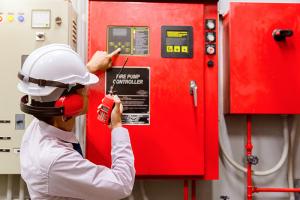ASHRAE guidelines and standards open for comment
The below drafts are open for 45-day public reviews
BSR/ASHRAE/IES Addendum ca to ANSI/ASHRAE/IES, Standard 90.1-2022, Energy Standard for Sites and Buildings Except Low-Rise Residential Buildings (first public review draft). Commenting is open April 11 to May 26.
This document proposes changes to the ASHRAE/IES Standard 90.1-2022 with a focus on energy efficiency. For health care facilities, the key changes include cleanup of existing energy credit language, introduction of new energy credits and changes to energy credits and load management credit requirements.
BSR/ASHRAE Standard 241P, Control of Infectious Aerosols (first publication public review). Commenting is open April 25 to June 9.
This standard is ASHRAE’s first in more than a century to set requirements for control of airborne disease transmission in non-health care facilities. It addresses requirements for minimum clean airflow, air distribution, use of filters and air cleaners, and the assessment, planning, and implementation process for all types of occupiable space, including residential and health care spaces. It is complementary to standards that specify requirements for acceptable indoor air quality. It is intended to be used to enable systems to exceed the requirements of these standards when necessary. One of the main advances of Standard 241 is that it sets requirements for Equivalent Clean Airflow per person for Infection Control (ECAi), permitting air that is filtered or treated by air cleaners to be used on an equal footing with outdoor air. In support of this approach, it sets extensive requirements for effectiveness and safety testing of filtration and air cleaning systems.
BSR/ASHRAE/IES Addendum bk to ANSI/ASHRAE/IES Standard 90.1-2022, Energy Standard for Sites and Buildings Except Low-Rise Residential Buildings (second public review draft). Commenting is open May 16 to June 30.
This updated version of Addendum bk establishes requirements for utilizing an electric or fuel-fired heat pump as the initial heat source where air-cooled or air-source HVAC systems serve building areas that are both heated and cooled. Life cycle cost analyses show that systems using air-source heat pumps combined with natural gas furnaces can offer lower upfront and annual costs for most climate zones, but climate zones 1A and 2A will see an increase in greenhouse gas emissions due to the lower cooling efficiency of heat pumps (as compared to air conditioners).
BSR/ASHRAE/IES Addendum cy to ANSI/ASHRAE/IES Standard 90.1-2022, Energy Standard for Sites and Buildings Except Low-Rise Residential Buildings (first public review draft). Commenting is open May 16 to June 30.
This update improves humidity control by using dew point temperature instead of relative humidity and making set points flexible instead of strict. It also ensures humidity sensors are more accurate and adjusts cooling system rules to work better. There’s an exception for multi-zone HVAC systems, and new limits on dehumidification when spaces are unoccupied (this could have negative impacts for spaces in hospitals where sterile supplies need to be protected). These changes don’t add major costs but do require humidity sensors in all HVAC zones to help manage air quality efficiently. Systems with digital controls can allow temporary humidity increases as long as the average stays within safe limits. Overall, the goal is to save energy while keeping humidity levels under control.
The below drafts are open for 30-day public reviews
BSR/ASHRAE/ASHE Addendum v to ANSI/ASHRAE/ASHE Standard 170-2021, Ventilation of Health Care Facilities (first public review draft). Commenting is open April 18 to May 18.
This proposed addendum follows up on action earlier this year when the committee expanded the minimum definition of a HEPA filter to include those filters classified under test methods more commonly used outside the United States. The reason behind this was to offer better guidance to international users of Standard 170 and to follow through on ASHRAE’s desire to be a more global organization. For general ventilation air filters, there are two primary classification test standards: the MERV rating system, based on ASHRAE 52.2; and the ISO 16890 standard, which replaced the European Norm (EN 779) a few years ago. This proposed addendum provides equivalencies between ASHRAE 52.2 and ISO 16890 with regard to minimum filtration required by Standard 170.
ASHRAE/ASHE Addendum w to ANSI/ASHRAE/ASHE Standard 170-2021, Ventilation of Health Care Facilities (first public review draft). Commenting is open April 25 to May 25.
Bronchoscopy procedures are performed in many locations depending on clinical need, which may mean that they are not performed under ventilation conditions currently specified in ASHRAE/ASHE 170 (i.e., for patients in an ICU setting who cannot be moved or in an operating room as needed by a patient undergoing surgery). The listing in ASHRAE/ASHE 170 should specify the minimum requirements for ventilation provided in a room designed as a dedicated space for performing bronchoscopies (and/or other procedures such as endoscopy, which may be performed in a negative pressure environment). This addendum adds the word “room” after Bronchoscopy in the Tables 7-1 and 8-1, as well as where rooms for bronchoscopy are mentioned in the text. Additionally, reference to bronchoscopy rooms was removed from footnote p for Tables 7-1 and 8-1, as it was deemed unnecessary.
BSR/ASHRAE/IES Addendum ct to ANSI/ASHRAE/IES Standard 90.1-2022, Energy Standard for Sites and Buildings Except Low-Rise Residential Buildings (first public review draft). Commenting is open May 16 to June 15.
The purpose of Addendum ct is to update the mechanical systems in Section 12 to coordinate with the new prescriptive HVAC requirements proposed in 90.1-2022 Addendum bk.
BSR/ASHRAE/IES Addendum db to ANSI/ASHRAE/IES Standard 90.1-2022, Energy Standard for Sites and Buildings Except Low-Rise Residential Buildings (first public review draft). Commenting is open May 16 to June 15.
This addendum creates a new defined term for compressed air primary storage and inserts the definition in Section 10.4.6.1 where appropriate.




